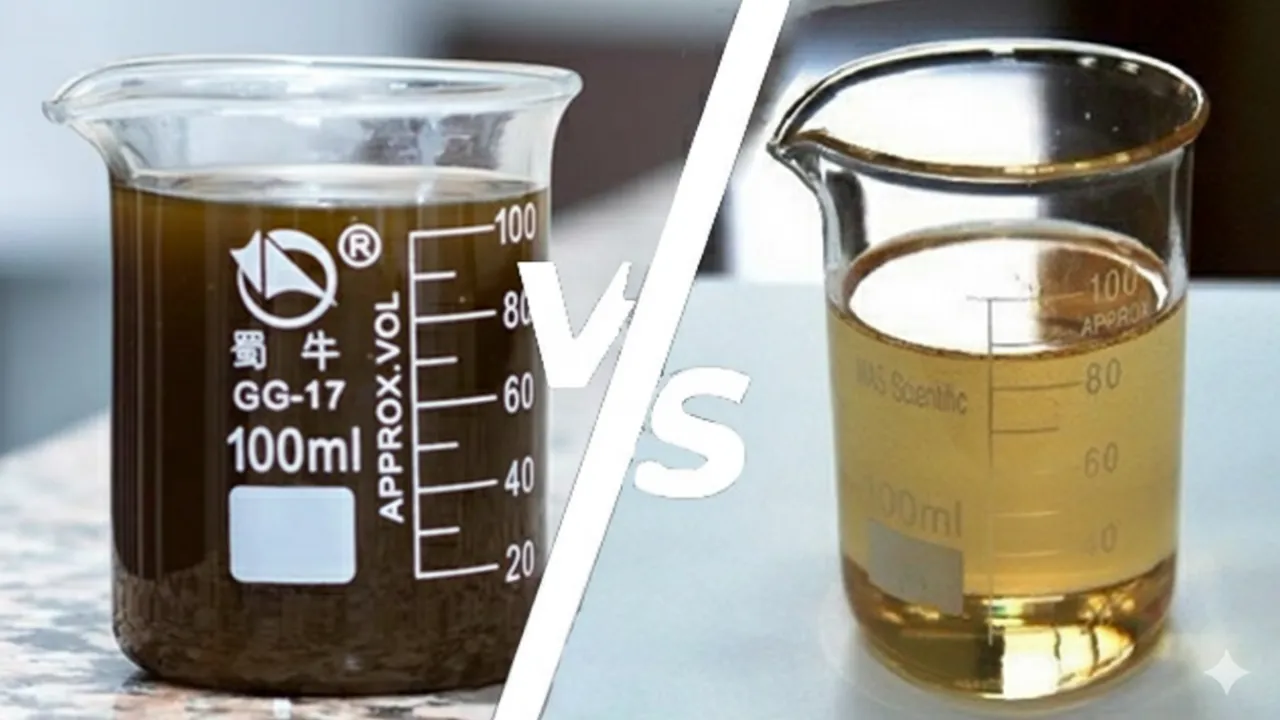Difference between LABSA and LAB

In the complex ecosystem of surfactant and detergent manufacturing, few raw materials are as fundamental as Linear Alkyl Benzene (LAB) and Linear Alkyl Benzene Sulfonic Acid (LABSA). While their acronyms are often mentioned in the same breath, a precise understanding of their distinct properties, production pathways, and commercial applications is critical for formulators, procurement specialists, and industry stakeholders.
This in-depth analysis moves beyond a basic comparison to explore the technical nuances and strategic importance of the LAB vs. LABSA dynamic, providing a clear framework for informed decision-making in product development and sourcing.
An In-Depth Look at Linear Alkyl Benzene (LAB)
Chemical Definition and Structure
Linear Alkyl Benzene (LAB) is an organic compound belonging to the alkylbenzene family. Its molecular structure consists of a benzene ring attached to a linear (straight-chain) alkyl group, typically containing 10 to 14 carbon atoms. This linearity is a deliberate and crucial feature, as it confers a high degree of biodegradability to its downstream derivatives, a significant advantage over earlier branched-chain alkylbenzenes.
Production Process: A Closer Look
The industrial production of LAB is a sophisticated petrochemical process, primarily involving the alkylation of benzene. Two leading technologies dominate the market:
-
The HF (Hydrofluoric Acid) Process: A long-established method where benzene is alkylated with linear olefins (e.g., n-paraffins) using hydrofluoric acid as a catalyst. This process is known for its high efficiency and product quality.
-
The Detal™ Solid Catalyst Process: A more modern, fixed-bed catalytic process developed by UOP. This method is gaining prominence due to its inherent safety advantages, as it eliminates the handling and disposal of volatile hydrofluoric acid. The process uses a solid catalyst to facilitate the reaction, aligning with the industry’s shift towards safer, more environmentally benign technologies.
The resulting product undergoes extensive purification, including distillation and clay treatment, to remove unwanted by-products like heavy alkylates, yielding a high-purity LAB essential for optimal sulfonation.
Primary Applications and Market Role
LAB’s primary value is as a key intermediate or precursor. It is not a surfactant itself but the essential building block for them.
-
Primary Derivative: Over 90% of global LAB production is dedicated to the synthesis of LABSA and, subsequently, Linear Alkylbenzene Sulfonate (LAS).
-
Other Industrial Uses: Beyond surfactants, LAB finds niche applications as a plasticizer, in the formulation of emulsifiers for agricultural chemicals, and as a component in certain specialty polymers and drilling fluids.
Deconstructing Linear Alkyl Benzene Sulfonic Acid (LABSA)
Chemical Definition and Structure
Linear Alkyl Benzene Sulfonic Acid (LABSA) is the direct sulfonated derivative of LAB. The introduction of a sulfonic acid group (–SO₃H) onto the benzene ring via a vigorous chemical reaction fundamentally transforms the molecule’s properties. This conversion creates a strong acid and, more importantly, a powerful anionic surfactant precursor. The general formula can be represented as R-C₆H₄-SO₃H, where ‘R’ is the linear C10-C14 alkyl chain.
Production Process: The Sulfonation Step
The transformation of LAB into LABSA is achieved through sulfonation, typically using sulfur trioxide (SO₃) gas. This is a highly exothermic and precise reaction, often carried out in a continuous, thin-film reactor, such as a falling film reactor. This reactor design ensures excellent heat control and mass transfer, critical for producing a high-quality, light-colored LABSA while minimizing undesirable by-products like sulfones.
The crude sulfonic acid is then typically hydrolyzed and aged to complete the reaction, resulting in the viscous, brownish liquid that is commercial LABSA. It is important to note that LABSA is rarely the final product used in consumer goods; it is most often neutralized to form its salt.
Primary Applications and Functional Role
LABSA’s primary role is as the active surfactant agent or its direct precursor.
-
Detergent and Cleaner Formulations: Upon neutralization with bases like sodium hydroxide (caustic soda), LABSA is converted into Sodium Linear Alkylbenzene Sulfonate (LAS), the most widely used synthetic surfactant in the world. It is the workhorse in:
-
Household and Industrial Laundry Detergents (powder and liquid)
-
Dishwashing Liquids and Hard Surface Cleaners
-
Personal Care Products, such as shampoos and bath soaps
-
-
Functionality: The molecule’s structure features a lipophilic (oil-attracting) alkyl chain and a hydrophilic (water-attracting) sulfonate group. This amphiphilic nature allows it to absorb at interfaces, drastically reduce surface tension, emulsify oils, and suspend dirt, which are the core mechanisms of cleaning.
LAB vs. LABSA: A Systematic Comparative Analysis
The following table provides a detailed, point-by-point comparison to crystallize the differences.
| Parameter | Linear Alkyl Benzene (LAB) | Linear Alkyl Benzene Sulfonic Acid (LABSA) |
|---|---|---|
| Chemical Nature | Hydrocarbon (alkylbenzene). Neutral organic compound. | Organosulfur compound. Strong organic acid. |
| Molecular Formula | ~C₆H₅-C₁₂H₂₅ (varies with alkyl chain length) | ~C₁₈H₃₀SO₃ (acid form) |
| Physical State | Colorless to pale yellow liquid. Oily feel. | Dark brown, viscous liquid. |
| Production Process | Alkylation of benzene with linear olefins. | Sulfonation of LAB using SO₃ gas. |
| Solubility | Hydrophobic. Insoluble in water; soluble in organic solvents. | Hydrophilic. Soluble in water, forming a micellar solution. |
| Primary Function | Intermediate/Raw Material. A building block with no inherent surfactant properties. | Surfactant Precursor/Active Ingredient. Possesses excellent surface-active properties. |
| Reactivity | Relatively stable. Reacts primarily under alkylation or sulfonation conditions. | Highly reactive, corrosive acid. Reacts with bases to form salts (e.g., LAS). |
| Handling & Storage | Requires standard chemical storage for hydrocarbons. | Requires corrosion-resistant equipment (e.g., SS316, polyethylene) and careful handling due to its acidity. |
Strategic Importance and Industry Trends
The choice between sourcing LAB or LABSA is not merely technical but a strategic supply chain decision with significant cost, environmental, and performance implications.
Supply Chain Considerations
-
Backward Integration: Large detergent manufacturers may opt to purchase LAB and operate their own sulfonation plants. This provides greater control over the LABSA quality, cost structure, and the flexibility to produce custom blends.
-
Forward Integration: For many smaller to mid-sized formulators, sourcing ready-to-use LABSA is more practical, as it eliminates the capital expenditure and operational complexity of managing a sulfonation unit.
Environmental and Regulatory Landscape
The LAB vs. LABSA narrative is deeply intertwined with environmental performance. LAS, derived from LABSA, is recognized for its rapid and complete biodegradability in both aerobic and anaerobic conditions. This has made it the environmentally preferred choice over non-biodegradable surfactants. Regulatory frameworks worldwide, particularly in Europe and North America, continue to encourage the use of readily biodegradable chemicals, securing LABSA’s position in the market.
Market Outlook and Future Directions
The global market for LAB and LABSA remains robust, driven by population growth, urbanization, and rising hygiene standards in developing economies. Key trends include:
-
Capacity Expansion: Significant new production capacities are coming online in the Middle East and Asia to meet growing global demand.
-
Feedstock Dynamics: The LAB market is sensitive to the price and availability of its key feedstocks: benzene and n-paraffins.
-
Performance Optimization: Research continues to focus on optimizing LABSA performance in cold-water detergents and in combination with other surfactants and enzymes to enhance cleaning efficiency and sustainability profiles.
Conclusion
The LAB vs. LABSA distinction is a fundamental concept in surfactant chemistry. LAB is the indispensable precursor, the product of sophisticated petrochemical synthesis. LABSA is the functional intermediate, born from a precise sulfonation reaction, that delivers the cleaning power demanded by modern consumers.

